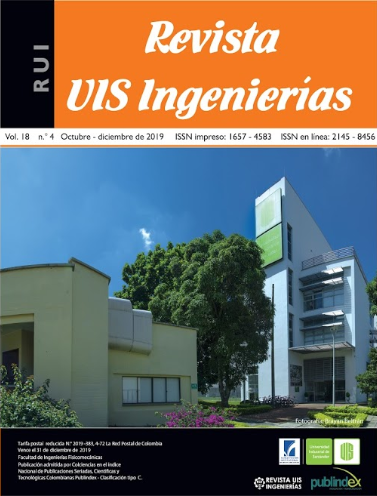Use of recycled diatomaceous earth from breweries as a means of transporting of macronutrients
Published 2019-09-16
Keywords
- diatomaceous earth,
- macronutrients NPK,
- Electrical conductivity (EC),
- total dissolved solids (TDS)
How to Cite
Copyright (c) 2019 Revista UIS Ingenierías

This work is licensed under a Creative Commons Attribution-NoDerivatives 4.0 International License.
Abstract
It is reported the physical-chemical characterization of recycled diatomaceous earth from the brewing industry, and its use as a means of transport of macronutrients (Nitrogen, Phosphorus, Potassium (NPK)), in order to provide an environmentally friendly alternative to the waste generated in the subprocess of the beer filtration. For the conformation of the samples (pellets) by extrusion, carboxymethyl cellulose (CMC) and corn starch were used to binders, while the wetting was carried out using a commercial liquid solution with 15% NPK, in low, medium and high concentration, which was added during the pellet forming process. The chemical characterization of the samples was done using atomic absorption spectroscopy (AA), and microanalysis by dispersed energy spectroscopy (EDS), the surface morphology was studied using scanning electron microscopy (SEM). The behavior of the macronutrient return capacity to an aqueous medium was carried out by means of the analysis of the electrical conductivity (EC) and total dissolved solids (TDS) as a function of time using the SI Analytics 680 K multiparameter. It was found that the sample that did not present loss of its structure in aqueous medium was formed by 60% of diatomite, 10% of CMC and 30% of corn starch (%w/w). Also the increase in the time of the EC and TDS of the aqueous solution when the activated pellets were submerged was observed, inferring that these are a good means of transporting macronutrients, which can be used as fertilizer in agricultural applications contributing to the environment.
Downloads
References
[2] L. Fillaudeau, P. Blanpain-Avet, and G. Daufin, “Water, wastewater and waste management in brewing industries,” J. Clean. Prod., vol. 14, no. 5, pp. 463–471, 2006. doi: 10.1016/j.jclepro.2005.01.002.
[3] N. Ediz, İ. Bentli, and İ. Tatar, “Improvement in filtration characteristics of diatomite by calcination,” Int. J. Miner. Process., vol. 94, no. 3, pp. 129–134, 2010, doi: 10.1016/j.minpro.2010.02.004.
[4] T. R. dos S. Mathias, V. M. F. Alexandre, M. C. Cammarota, P. P. M. de Mello, and E. F. C. Sérvulo, “Characterization and determination of brewer’s solid wastes composition,” J. Inst. Brew., vol. 121, no. 3, pp. 400–404, Jul. 2015, doi:10.1002/jib.229.
[5] M. Evans, “Learn the 3 Rs: Reduce, Reuse, and Recycle,” The Balance Small Business, 2017. [En línea]. Disponible en: https://www.thebalancesmb.com/the-3-r-s-reduce-reuse-and-recycle-3157809.
[6] M. Iliescu, M. Farago, M. Popa, and M. CRISTEA, “Reuse of residual kieselguhr from beer filtration as a fertiliser,” J. Environ. Prot. Ecol., vol. 10, no. 1, 2009.
[7] FAO, “Agricultura mundial: hacia los años 2015/2030,” 2002.
[8] G. Dessalew, A. Beyene, A. Nebiyu, and M. L. Ruelle, “Use of industrial diatomite wastes from beer production to improve soil fertility and cereal yields,” J. Clean. Prod., vol. 157, pp. 22–29, 2017, doi: 10.1016/j.jclepro.2017.04.116.
[9] W. E. Cotching, “Organic matter in the agricultural soils of Tasmania, Australia – A review,” Geoderma, vol. 312, pp. 170–182, 2018, doi:https://doi.org/10.1016/j.geoderma.2017.10.006.
[10] F. Ramukhwatho, A. Seetal, and H. Pienaar, Water and Wastewater Management in the Malt Brewing Industry, no. Edition 2. Republic of South Africa, 2016.
[11] G. K. Adamu and A. K. Aliyu, “Determination of the Influence of Texture and Organic Matter on Soil Water Holding Capacity in and Around Tomas Irrigation Scheme, Dambatta Local Government Kano State,” Res. J. Environ. earth Sci., vol. 4, no. 12, 2009.
[12] F. Borro Muentes, “Estudio de la eficacia de los aglutinantes en la disolución del metronidazol tabletas 250 mg,” Universidad de Guayaquil. Facultad de Ciencias Químicas, 2001.
[13] L. A. Fonseca, E. Trujillo-castro, and G. Peña-rodríguez, “Tortuosidad y permeabilidad de materiales cerámicos mesoporosos de caolín y diatomita Tortuosity and permeability of mesoporous ceramics of kaolin and diatomite,” Rev. UIS Ing., vol. 18, no. 1, pp. 111–117, 2019, doi:10.18273/revuin.v18n1-2019009.
[14] M. Ibrahim et al., “Avances de Investigación 27,” Agroforestería en las Américas, vol. 45, 2007.
[15] C. Gamarra, M. D. Lezcano, M. V. de Ortíz, M. Galeano, and A. C. Cardús, “Relación carbono-nitrógeno en suelos de sistemas silvopastoriles del Chaco paraguayo,” Rev. Mex. Ciencias For., vol. 9, no. 46, Mar. 2018, doi: 10.29298/rmcf.v9i46.134.

